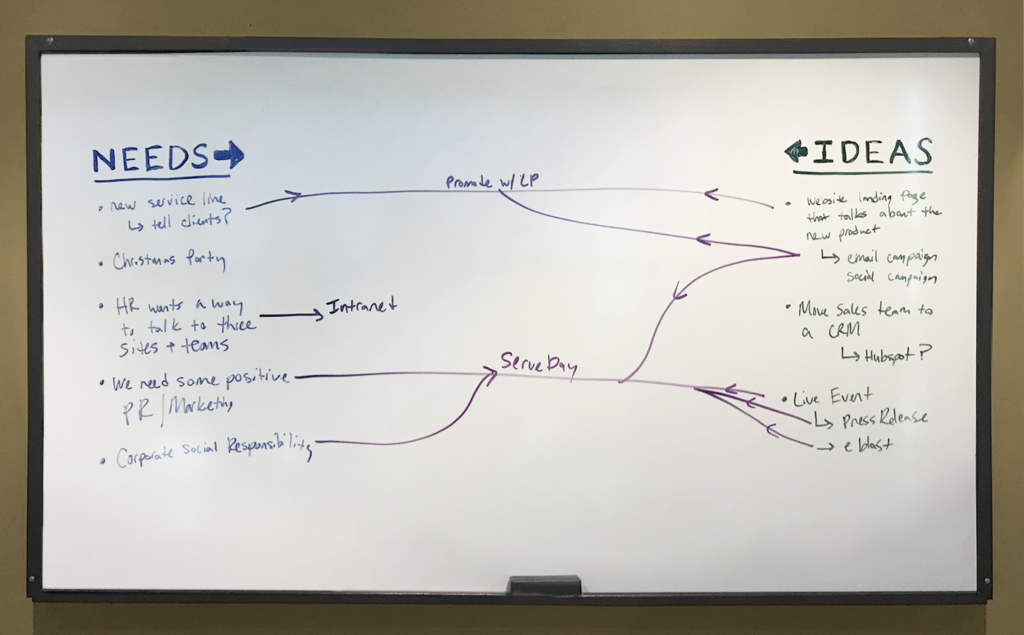
Ideation Automation
Kill Bad Brainstorming and Start a Creativity Revolution
Brainstorming is Bad
Or more accurately brainstorming is not efficient. Brainstorming is usually done through one off meetings, pulling in team members that have other day jobs to try and come up with a usable idea or solution for a particular problem at hand.
If you run a business where you rarely have problems I guess this might be a good solution. Most organizations run into problems all the time, and it when it comes to communications and marketing in particular, problems and needs show up just about every day.
Create a Culture Shift
Rather than retroactively trying to conquer your problems as they come, engage your team in a proactive Culture of Ideation to automate your ideas. Here’s what that looks like:
- A consistent team of ideators with special one time invites for additional members
- An always on the books tentpole ideation meeting at regular intervals (weekly, biweekly, monthly)
- A whiteboard for NEEDS/IDEAS flow diagramming
- A digital sandbox for ideation outside the tentpole meeting
Select Your Team
Pull together a braintrust of ideators. They don’t need to all be “creatives”, rather put together a team with diverse backgrounds and skills. The one requirement is that they have buy-in with the Ideation Culture. If they think it’s a waste of time, for them, it probably is. Find team members who can see the long term value in building ideas on a regular basis to fuel your company and keep you progressing forward.
Have A Meeting, Then Another, Then Another
Find a good time in your weekly, biweekly, or monthly schedule for your regular Ideation Session. The key word here is “regular”. Your team needs to know that this meeting is coming, and it will keep coming at consistent intervals. This is where the Culture of Ideation beats brainstorming. Sure, you can get together and power through, coming up with a one off idea when you’re in a pinch. But if your team knows that a valuable idea they had in the shower yesterday will actually have a place for everyone to discuss and dream together (out of the shower with clothes on, obviously) they will be more likely to submit those ideas.
Draw Your Ideas Together

Use a big ole whiteboard, or big notepad if that’s all you got. On the left hand side write the word “NEEDS” and put an arrow pointing right next to it. Then on the right hand side write the word “IDEAS” and put an arrow pointing left. Take all of the ideas that have come up over the week and have them written on the IDEAS column. On the NEEDS column write out any upcoming events, problems, and processes that need some solutions. Then start discussing the needs and the ideas that have already been put out there and add more as they come up. As you start to see ideas that can meet your needs start moving them to the middle of the board. This is where you can develop workable tactics from ideas to meet your needs.
Digital or it Didn’t Happen
Document all of the ideas that happen inside and outside of the meeting using a digital sandbox of some sorts. I’m not opposed to using a shared Google Doc but that sounds pretty lame, so if you want to be cool use Trello. It’s free and the card organization is super easy to pick up with a quick learning curve for beginners. Make sure that everyone on the team (and maybe even leadership outside of the braintrust) has the ability to quickly add new ideas and needs to the board. The digital sandbox is not just an easy way to collect ideas and organize your meeting, but a great way for your team to ideate when inspiration hits them.
Why This Works
Don’t let the glasses fool you, I am no scientist. I can’t tell you statistics on how much this will improve your processes. What I can tell you is why it works, and that’s Kyle.
I was on a dedicated creative team that used regular ideation meetings to meet our weekly planning needs. As the leader of the meeting, I was rarely sitting down, and I had a good view of my team and how they worked. One day my project manager came to me and said, “I’m worried about Kyle. He never talks in the meetings, he just looks bored or maybe like something is wrong with him.” I laughed, and said, “Oh no, he’s doing just what he’s supposed to be. See he’s quiet in our Tuesday meeting because he’s pretty introverted and not a fast talker. He makes his contributions on Wednesdays at the coffee bar one-on-one with me. He’ll usually stop me with a killer idea, showing me examples on his phone, and gets excited at the idea.”
Kyle needed that meeting just as much as everyone else even though he rarely talked. He needed to be a part of that brain trust and have the confidence that when he came up with a great idea 24 hours later he would have a place for that idea to grow.
Why This Works for Everyone
Now I know what you’re saying, that you aren’t on a dedicated creative team with weekly project deadlines. As a business owner, I get that sentiment but want to encourage you to think a little more broadly at the value of ideas in your business. I know you have weekly problems to solve because your calendar is organized in weeks just like everyone else’s. Rather than trying to find solutions reactively, invest in using your team to create a proactive machine to confront your needs before they become problems. Invest in a Culture of Ideation and automate finding the best solutions while actually having the time to implement them effectively.
Now go grow.
-TBR
More from Black Raven

Why Funnels Can Still Help You Build a Marketing Strategy
In business, popular concepts go in and out of fashion, but certain principles remain constant. To find a successful path for your business, you need

Rebrand with Confidence, Strategy, and Creativity
We understand that rebranding isn’t simply about changing logos or giving your business a modern look. It starts with a strategic process that requires thoughtful

Maximizing Social Media Impact: Balancing Planned and Organic Content
In crowded digital spaces, strategic social media management is essential for businesses looking to stay on top and get noticed. But what’s the best approach?